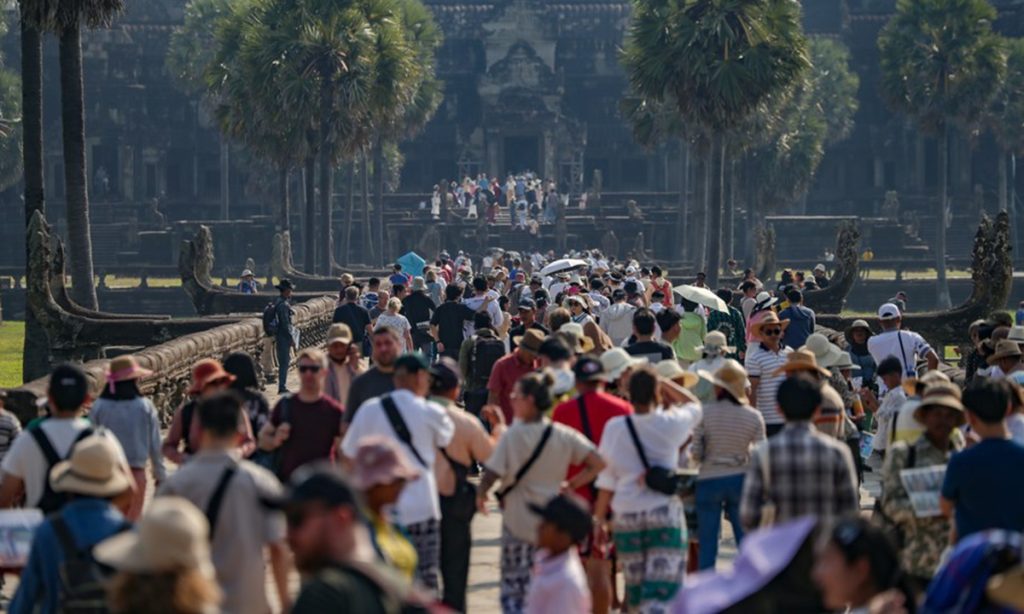Experiencing Cambodia’s charm: ‘a hidden gem’ rising among Chinese travelers

Cambodia is becoming a "hidden gem" destination in the eyes of Chinese travelers, Global Times reporters learned from a number of local tourism industry insiders on Thursday. With improvements in Chinese-language services, the rise of customized travel packages, and the strengthening of digital payment systems, Cambodia is becoming ever more attractive for Chinese tourists.
Walking through the streets of Phnom Penh, Global Times reporters saw Chinese characters everywhere - on billboards, LED screens and storefront signs. From the airport to the city center, familiar Chinese brands, such as Mixue Ice Cream & Tea and Haidilao Hotpot, lined the roads. Locals greeted Chinese visitors with warmth and sincerity, and many could easily exchange a few words in Putonghua - small gestures that made the welcome feel all the more genuine.
According to the latest report released by Cambodia's Ministry of Tourism, the country welcomed over 1.26 million international visitor trips in the first two months of this year, marking a 27.9 percent year-on-year increase. Among them, Chinese tourists accounted for 184,300 arrivals, representing a sharp 67.6 percent year-on-year growth. China has now become Cambodia's third-largest source of international tourists, following Thailand and Vietnam, the Cambodia China Times reported.
Zhou Yingping, general manager of China Southern Airlines Company Limited Phnom Penh office, highlighted Cambodia's Angkor Wat as a major draw for Chinese travelers - the country's most iconic attraction, a UNESCO World Heritage site and a symbol of Cambodia.
Other key destinations include the Royal Palace in Phnom Penh, a sacred site where generations of kings practiced Buddhism; the Koh Rong Island near Sihanoukville, ranked by CNN as one of the world's most beautiful beaches; the Tonlé Sap Lake, the largest freshwater lake in Southeast Asia and often referred to as Cambodia's "lake of life"; and the Elephant Valley Project in Mondulkiri.
"As Chinese-language services improve, along with the rise of customized travel packages and enhanced digital payment systems, Cambodia is becoming ever more attractive for Chinese tourists," Zhou said.
As one of the earliest airlines to establish an air route between China and Cambodia, China Southern Airlines launched its first regular round-trip flight between Guangzhou and Phnom Penh in 1999. Today, the airline operates three daily flights on this route. Leveraging its Guangzhou hub, China Southern offers connections to over 100 international destinations worldwide, as well as all major airports across China. This extensive network has maximized overall connectivity between the Cambodian capital to the world, Zhou said.
With the rise of social media platforms like Xiaohongshu, also known as RedNote, and China's major short-video platform Douyin, more travelers are sharing detailed itineraries and travel tips online, which has gradually influenced the way Chinese tourists plan their trips abroad.
In the China-Cambodia tourism market, there has been a noticeable shift from traditional group tours to independent travels, Zhou said. Classic travel routes - such as entering through Phnom Penh and departing from Siem Reap, or starting in Ho Chi Minh City of Vietnam and ending the trip in Siem Reap - have become especially popular among backpackers seeking more flexible and immersive experiences.
Dong Xiaoyan, a visitor from Jiaxing, East China's Zhejiang Province, shared her experience with the Global Times. "My husband has been working in logistics here for 11 years, so I brought my parents and the whole family to visit. We went to Siem Reap, Angkor Wat, Koh Rong Island in Sihanoukville and Phnom Penh. The travel experience was fantastic - the Cambodian people are simple, kind and welcoming, and it's very safe here, nothing like some of the negative things you see online."
She added, "I would definitely recommend Cambodia to my family and friends, especially during the Khmer New Year. The water festivals and all kinds of celebrations create such a relaxed and joyful atmosphere and make everyone feel really immersed in the joy and just live in the moment."
Hun Dany, Secretary of State and spokesperson for Cambodia's Ministry of Tourism, said during a recent forum that under the framework of the Comprehensive Strategic Partnership between Cambodia and China, tourism has become a key pillar of bilateral cooperation. "China has long been one of Cambodia's most important sources of international tourists," she said. "We will take the opportunity of the 2025 Cambodia-China Year of Tourism to further improve tourism services, aiming to surpass pre-pandemic levels."
Dany said the ministry will introduce a series of measures, including the diversification of tourism products to attract more Chinese visitors, adding that Cambodia is expected to attract over 1 million Chinese visitor trips in 2025.
Cambodian Minister of Tourism Huot Hak said in January that the growing number of Chinese tourists presents a significant opportunity for Cambodia, not only for the development of its tourism sector but also for creating new investment prospects in other areas of the local economy. He emphasized that the future of Cambodia's tourism industry is closely tied to the continued inflow of Chinese tourists and investors, China News Service reported.